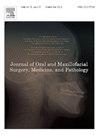爆竹口内爆炸造成广泛的颌面部损伤:罕见病例报告和文献综述
IF 0.4
Q4 DENTISTRY, ORAL SURGERY & MEDICINE
Journal of Oral and Maxillofacial Surgery Medicine and Pathology
Pub Date : 2024-05-29
DOI:10.1016/j.ajoms.2024.05.008
引用次数: 0
摘要
球形爆竹在口腔内爆炸造成复杂的上下颌骨损伤的情况非常罕见。恢复口腔功能、对齐牙齿以及达到最佳的美观和功能效果都具有挑战性。本病例报告的患者是一名 34 岁的男性,他在口腔内自行燃放鞭炮,导致下颌骨粉碎性骨折、牙槽骨骨折(上下前段)、多处软组织损伤,以及嘴唇、邻近皮肤、舌头和口咽部位的撕裂伤。在将患者转入口腔颌面外科之前,对其进行了紧急插管、输液复苏和止血。这些创伤需要大量清创和立即重建。患者接受了清创、冲洗、切开复位和小钢板内固定术。术后 3 个月、6 个月和 1 年的功能效果由华盛顿大学生活质量问卷(UW-QOL)进行评估。术后功能效果令人满意,尤其是吞咽和言语能力。面部软组织疤痕隐蔽良好,没有功能障碍。咬合对齐已完成,修复时使用了丙烯酸局部义齿。患者术后未出现任何并发症,如三叉神经痛或小口腔炎。本文章由计算机程序翻译,如有差异,请以英文原文为准。
An intraoral blast of firecracker caused extensive maxillofacial injury: A rare case report and literature review
The incidence of complex maxillomandibular injuries resulting from the intraoral explosion of spherical firecrackers is rare. Restoring oral function, aligning teeth, and achieving optimal aesthetic and functional outcomes are challenging. This case report presents a 34-year-old male patient who self-lit firecrackers in his mouth and suffered comminuted mandibular fracture, dentoalveolar fracture (upper and lower anterior segment), multiple soft tissue injuries, and laceration of lip, adjacent skin, tongue, and oropharyngeal area. Before transferring the patient to oral and maxillofacial surgery unit, urgent intubation, fluid resuscitation, and bleeding control were performed. These traumas require considerable debridement and immediate reconstruction. The patient underwent debridement, irrigation, open reduction, and internal fixation with miniplates. Postoperative functional outcomes were assessed using the University of Washington Quality of Life Questionnaire (UW-QOL) at 3-month, 6-month and 1-year. Functional outcomes, especially swallowing and speech, were satisfactory. The facial soft tissue scar was well hidden, with no functional impairment. Occlusal alignment was achieved, and an acrylic partial denture was used for rehabilitation. The patient did not experience any post-surgical complications such as trismus or microstomia.
求助全文
通过发布文献求助,成功后即可免费获取论文全文。
去求助
来源期刊

Journal of Oral and Maxillofacial Surgery Medicine and Pathology
DENTISTRY, ORAL SURGERY & MEDICINE-
CiteScore
0.80
自引率
0.00%
发文量
129
审稿时长
83 days
 求助内容:
求助内容: 应助结果提醒方式:
应助结果提醒方式:


